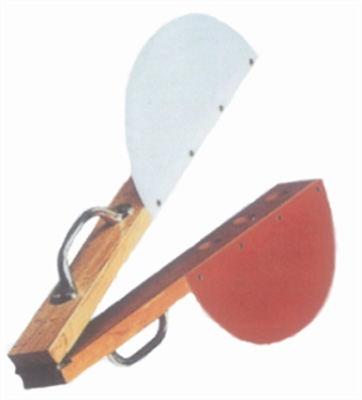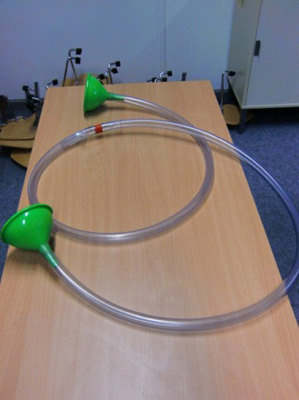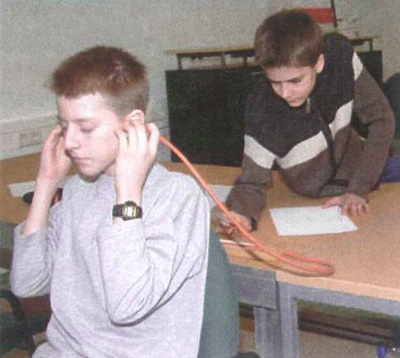Session 5: Sound source detection
Objectives: When trying to catch sight of an airplane in the sky we first follow our hearing impression and realize that in many cases the plane can be found at a different place.
Humans are able to detect the direction from which a sound is coming from. But as the speed of sound differ observable from the speed of light it gets more difficult with increasing distance to the source. In this session the pupils will
- experience the accuracy of the humans ability to detect the direction of a sound source
- understand the technique the human brain uses for this (recognizing the delay between the sound reaching left and right ear depending on the distance to the source)
- perceive the finite speed of sound, which is responsible for the time delay between the ears.
Sound waves propagate with a speed depending on the media they travel through. In Air at 20° C sound propagates with a speed of 343 m/s. This can be experienced for example in a thunderstorm. The light of a flash reaches the eyes nearly immediately while the sound of the thunder needs some time to reach our ears. The human ears can detect a time delay of a sound signal down to 30 µs and thereby are able to detect a direction very precisely.
Maximum duration
30 minutes
Material
- Tube
- 2 funnels
- Starting clap board or a pair of wooden blocks
- Stop watch
- Tape measure

fig 7 Starting clap board for measuring the speed of sound

fig 8 Tube with funnels for the experiment “directed hearing”

fig 9 Two pupils doing the experiment “direction hearing”
Introduction/Starters
Talk with the pupils about sound source detection. Do they think they can determine the direction from where a sound is coming from? How accurate do they think they can do it? How can they do it? What is the speed of sound and how can we measure it?
Main activities
Directed hearing: the two funnels get plugged to the tube, each on one end. One pupil holds both ends to his ears with the tube behind his back. Another one knocks with a pencil on to the tube somewhere around the middle. Now the listening one tells on which side it was knocked on. Discuss how this may be possible.
Measure the speed of sound using a starting clap board or pair of wooden blocks: find a building with a large, flat outside wall and enough free space in front, so that you can hear an echo coming back from it. Stand as far away from it as possible and measure the distance to the wall. One of the pupils is equipped with the starting clap board and another one with the stop watch. The time starts with the first clap, the pupil with the starting clap board claps again as soon as he can hear the echo. He does this ten times. Then the other one stops the time. Now they can calculate the speed of sound by dividing twice the distance to the wall by 1/10th of the time for the ten claps. (Maybe for younger pupils: use a ball to demonstrate “reflection” prior to the experiment)
Conclusion/Plenary
Sound waves propagate with a speed depending on the media they travel through. This causes a time lag in the sound signals received at different distances to the sound source. In this session it should be understood, that because of the finite speed of sound a detection of the direction of a sound source is possible. Bats, whales and dolphins use this effect to navigate. They send out a signal and wait for the echo to locate obstacles.
